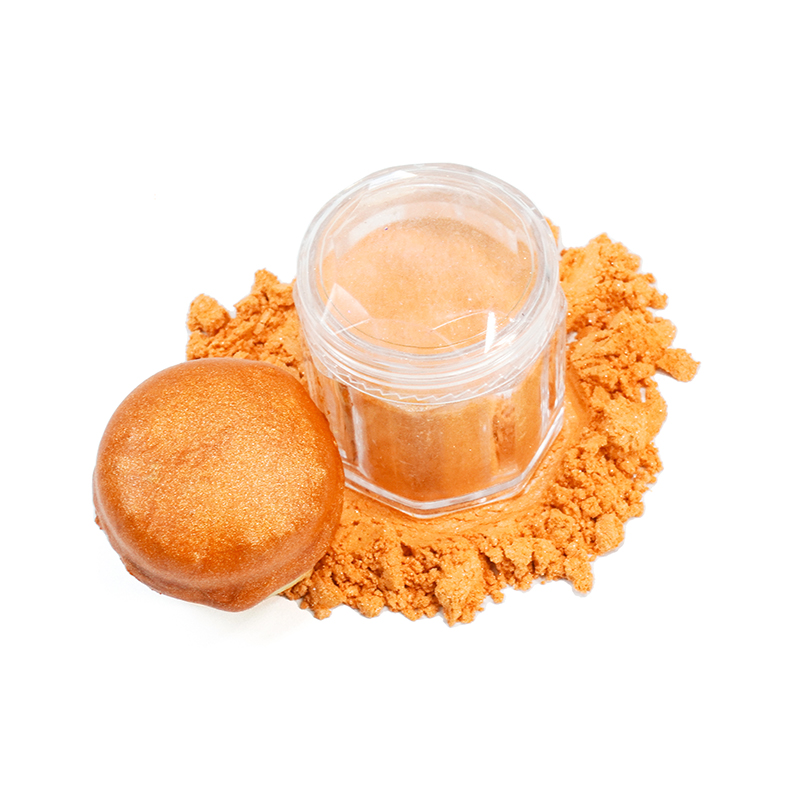
If you sell decorated desserts in stores or online, shimmer can be a friend or a headache. The right finish lifts perceived value, photographs cleanly, and survives a night in the display case. The wrong finish dulls under LEDs, smears in transit, and brings label questions you do not want. E171-free edible luster dust lets you keep the shine while moving toward cleaner labels and smoother audits.
Who Needs This Guide?
This guide fits brand owners, bakery factories, chain cafés, and decorators who ship or display finished goods. You want color that reads well on camera, holds up after refrigeration, and passes buyer checks without drama. If your team manages OEM or ODM lines, the stakes feel even higher on consistency and paperwork.
What Does “E171-Free” Change in Real Operations?
E171 refers to titanium dioxide. Many buyers now ask for color systems without it. Moving to E171-free edible luster dust simplifies label conversations and aligns with clean-label goals for many markets. It also pushes you toward pigment systems and particle sizes that behave well on food surfaces.
Clean Label And Compliance
Professional luster dust programs publish full ingredient lists with standard E-numbers and supply certificates on request. Reputable producers manufacture and pack in GMP facilities, with documentation such as ISO9001 and BSCI, and can provide Kosher certificates and Halal statements. Ingredient conformity often cites FDA CFR Part 73/74 and applicable EU color rules.
How Does Luster Dust Affect Shelf-Life?
Finishes fail for three common reasons: water activity, abrasion, and poor layer control. A food-grade dust designed for desserts helps on all three. Products in this category are positioned for cake decorating, beverages, cookies, and chocolate, with directions that favor thin layers and dry surfaces for a stable sheen.
Storage, Age, And Jar Care
Open-jar hygiene and storage matter. Many lines state a shelf life up to five years when jars stay tightly sealed and stored cool, dry, and dark. That sounds simple, but it saves batches from clumping and color shift.
Abrasion And Transit
Rubbing during last-mile delivery causes flat spots. Particle size control reduces scuffing, especially on high-touch edges. Professional catalogs list size bands from fine pearl ranges to larger glitter sizes; selecting a size suited to the surface reduces damage risk in transit.
Why Do Photos Look Better With E171-Free Sparkle?
On camera, glare kills detail. A clean sparkle should give depth, not a flat white patch. E171-free systems rely on pearlescent effects and controlled particle geometry, so highlights read as lines and points rather than a hard flare. In beverage work, shimmer variants even glow under UV, which tells you how the optics scatter light. That quality can be used for hero shots or event menus.
Lighting And Camera Tips
- Set white balance to the case lighting temperature; test 3000 K and 5600 K
- Move the key light slightly off-axis to avoid specular hotspots
- Use a polarizer only if the shimmer looks too harsh
- Favor mid-tone backgrounds so the sparkle pops without clipping
Which Application Methods Hold Up In Display?
Method choice drives both durability and look. If the cake rests in a cold case, film-forming mixes can crack. If the item ships in trays, heavy coats pick up rub marks. Test a panel in the same conditions as service.
Dry Dusting
Use on firm fondant or embossed panels. Chill the surface slightly, load a soft brush, tap off excess, then sweep in one direction. Build coverage with two light passes, not one heavy pass.
Paint Mix
Mix dust with clear alcohol or lemon extract until fluid. Paint in short strokes and let it flash before a second pass. Keep solvent out of seams to avoid pooling.
Misting
Make a thin solution and move a small pump sprayer side to side from about 20 cm. Rotate the cake so the mist lands evenly. Test the nozzle pattern with water first.
Surface × Method Matrix
| Surface Type | Best Method | Notes |
| Fondant | Dry dusting | Clean grain, no pooling |
| Buttercream | Paint mix | Chill first for a firm pass |
| Modeling chocolate | Paint mix | Short strokes, quick flash |
| Chocolate drips | Misting | Even sparkle on curved lines |
If you need a quick refresher mid-shift, save a link labeled sparkle luster dust so the team can confirm ratios and finishes from the same page.
How Do You Control Batches So Every Unit Matches?
Consistency turns a good finish into a standard. Record what you do, set environmental targets, and add three simple QC checks before boxing.
Batch Cards
Log lot number, coat count, solvent ratio, rest times, and case lighting notes. Keep cards with sample photos for reference.
Room Targets
Hold finishing rooms within stable temperature and humidity bands. Small side fans can help air exchange without stirring dust.
QC Gates
Run a quick rub test on an edge, a refrigeration cycle test, and a box vibration test. Ten minutes here reduces rework later.

What Packaging And Transit Changes Protect The Finish?
If rubbing causes dull spots, reduce movement. Add soft inserts or film sleeves so decorated zones do not touch the carton. Trim headspace and use tray heights that limit bounce. On store displays, check case lighting angle; a slight tilt can stop glare without dimming the case.
Where Does ROI Come From For B2B Buyers?
Waste reduction adds up in production math. A curated palette cuts jar waste and speeds shade picking. Single jars in 5 g or 10 g sizes are common, but many buyers favor sets like 10 colors at 5 g or 25 colors at 10 g, especially when rolling training or seasonal menus. Services can also include color selection, box design, and label work, which shortens your launch cycle.
Common Pack Options
| Option | Colors | Typical Size | Use Case |
| Single jar | 1 | 5 g or 10 g | Signature tones |
| Set | 10 or 25 | 5 g or 10 g | Menus and classes |
If you run multiple outlets, define two micro-palettes: warm metals for weddings and holidays, cool metals for branding work. Keep both in a labeled tray. It speeds pre-shift prep.
Which Color Strategy Works With 20-Color Palettes?
Start with warm metals like gold, copper, and rose gold for photos that need warmth. Use cool metals like pearl and silver for product pages and brand kits. Rotate seasonal accents: blush for spring weddings, emerald for winter menus, violet and blue for kids’ parties. Keep a light-to-deep tray layout to make picking faster during service.
What Clean-Label Documents Do Buyers Expect?
Distributors and retail buyers expect ingredient disclosures with E-numbers and clear statements about production and packing conditions. Ask for GMP packing notes and certificates, such as ISO9001 and BSCI. Many programs can also provide Kosher certificates and Halal statements. Regulatory notes often reference FDA CFR color parts and EC frameworks. These materials speed onboarding and cross-border checks.
If your team wants one place to file specs and pictures for review, save a bookmark named clean-label cake decoration and keep the latest documents with it.
What OEM/ODM Options Help Brand Owners Move Faster?
Private-label jars in 5 g, 10 g, or 25 g work well for classes and retail. Many suppliers curate sets and also help select colors, design boxes, and prepare labels. That means one contact for color, package, and barcode, which is simpler for launches and distributor handoffs.
Introduction to Hangzhou Yayang Industrial Co., Ltd.
YAYANG operates as a professional, FDA-registered producer of edible luster dust with manufacturing and packing inside GMP facilities. Documentation includes ISO9001 and BSCI, with Kosher certificates and Halal statements available to support diverse markets. Ingredient conformity references FDA CFR Part 73/74 and EU color regulations, and the color library spans over ninety shades for cakes, chocolates, beverages, sprinkles, and cocktails. Standard singles come in 5 g, 10 g, and 25 g, with curated sets for training or retail. OEM and ODM support covers shade selection, box design, and label creation, so your team can move from sample to shelf with fewer steps.
FAQ
Q1: Does E171-free sparkle hold up after a day in the case?
A: Yes, when applied in thin layers on dry surfaces and stored correctly. Professional ranges position usage on cakes, cookies, chocolates, and beverages for stable sparkle.
Q2: How long do unopened jars stay good?
A: Many lines state up to five years when sealed and kept cool, dry, and dark. Close lids promptly and avoid humid prep rooms.
Q3: What pack sizes work for multi-site brands?
A: Single jars in 5 g or 10 g support signature tones. Sets like 10 × 5 g or 25 × 10 g help training and menu cycles while cutting waste.
Q4: Can shimmer be used in drinks for photo shoots or events?
A: Yes. Beverage shimmer variants glow under UV and create a dramatic swirl, useful for hero shots and nightlife menus.
Q5: Which documents should a buyer request for clean-label claims?
A: Ingredient list with E-numbers, GMP packing note, ISO and BSCI certificates, plus Kosher and Halal as needed. FDA CFR and EU references help cross-border reviews.
